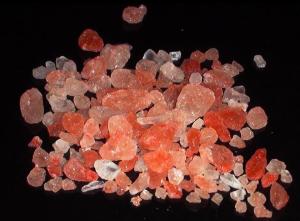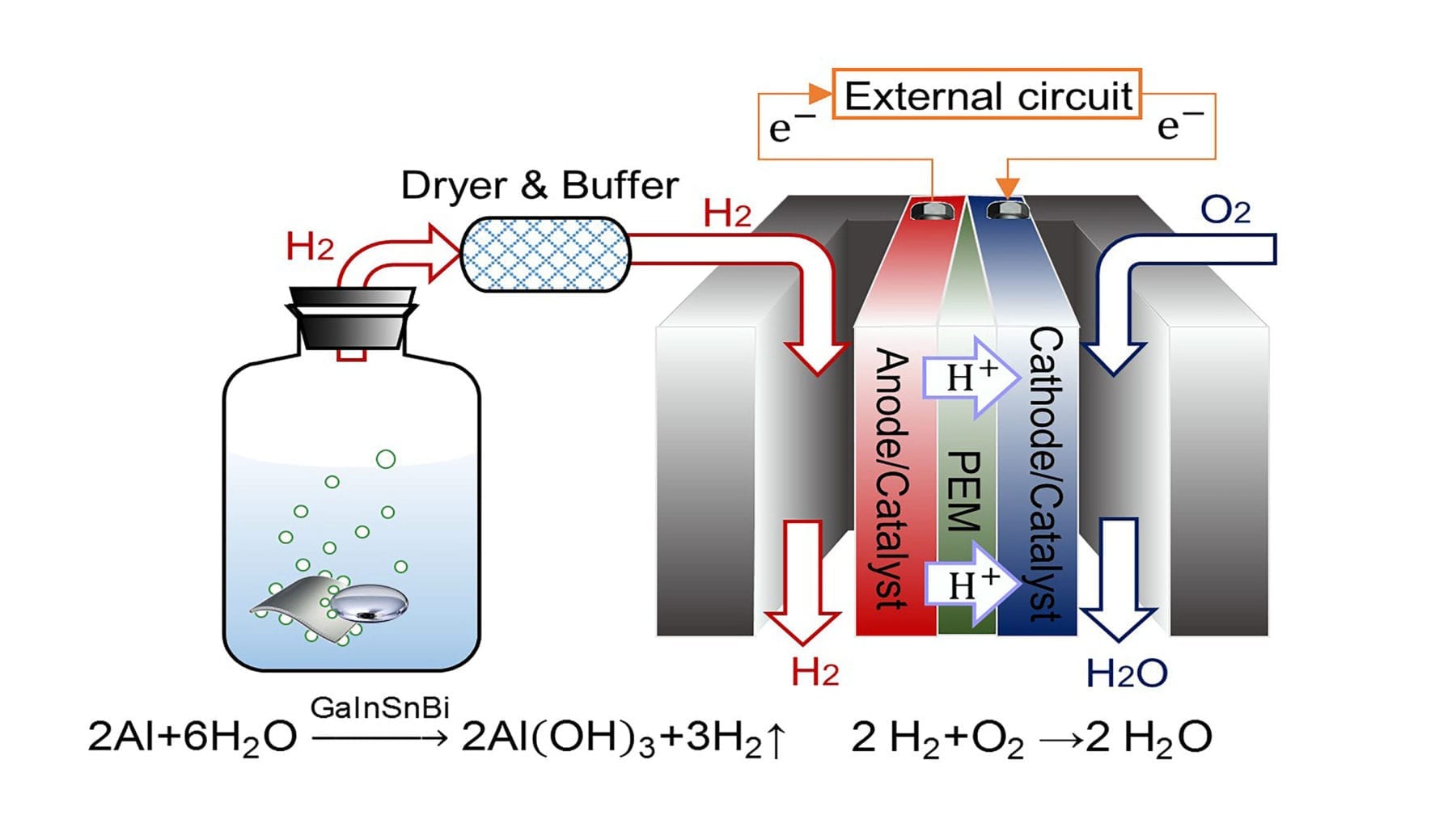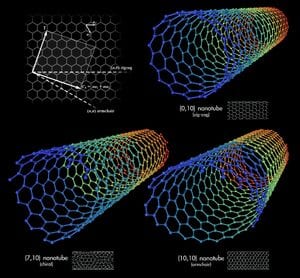
Could be a good candidate for fabrication of green energy devices that consume virtually infinite sources — salt water and sunlight.
A protein found in the membranes of ancient microorganisms that live in desert salt flats could offer a new way of using sunlight to generate environmentally friendly hydrogen fuel, according to a new study by researchers at the U.S. Department of Energy‘s Argonne National Laboratory.
Argonne nanoscientist Elena Rozhkova and her colleagues combined a pigment called bacteriorhodopsin with semiconducting nanoparticles to create a system that uses light to spark a catalytic process that creates hydrogen fuel.
Scientists have been aware of the potential of titanium dioxide nanoparticles for light-based reactions since the early 1970s, when Japanese researchers discovered that a titanium dioxide electrode exposed to bright ultraviolet light could split water molecules in a phenomenon that came to be known as the Honda-Fujishima effect. Since then, scientists have made continuous efforts to extend the light reactivity of titanium dioxide photocatalysts into the visible part of the spectrum. The promise of these photocatalysts prompted scientists to experiment with different modifications to their basic chemistry in hope of making the reaction more efficient, Rozhkova said.
“Titanium dioxide alone reacts with ultraviolet light, but not with visible light, so we used biological photoreactive molecules as a building block to create a hybrid system that could use visible light efficiently,” Rozhkova said.
Rozhkova and her colleagues turned to bacteriorhodopsin — which is responsible for the unusual purple color of a number of salt flats in California and Nevada — because it uses sunlight as an energy source that allows it to act as a “proton pump.” Proton pumps are proteins that typically straddle a cellular membrane and transfer protons from inside the cell to the extracellular space.
The Latest Bing News on:
Green Hydrogen Fuel
- FEF launches first-of-its-kind hydrogen station in the USon April 30, 2024 at 12:02 am
It’s a hydrogen refueling station dedicated to commercial H2 trucks. At first glance this might not sound much like a major feat, considering this isn’t th ...
- Hydrogen Offers Germany a Chance to Take a Lead in Green Energyon April 29, 2024 at 9:01 pm
A subsidiary of ThyssenKrupp, Germany’s venerable steel producer, is landing major deals for a device that makes the clean-burning gas from water.
- Hydrogen’s transformative potential as a fuel source for carson April 29, 2024 at 9:14 am
In the quest for carbon neutrality, Battery Electric Vehicles get all the hype. But does hydrogen offer unsung potential? Chris Farnell reports.
- Green hydrogen: A climate change solution or fossil fuel bait and switch?on April 29, 2024 at 5:18 am
To help solve the climate crisis, $750 million could flow to the Philadelphia region to create a hydrogen economy. But some say it’s a deceit to help the fossil fuel industry.
- Powering ahead with green hydrogenon April 28, 2024 at 10:00 am
Crown research institute GNS Science is about to officially open its new green hydrogen lab in Lower Hutt. One day it could contribute to making sure that small rural communities cut off by ...
- World’s first hydrogen station for commercial trucks opens – is it too late?on April 27, 2024 at 7:58 am
FirstElement Fuels has opened the world's first large-scale hydrogen fueling station for heavy-duty commercial trucks at Port of Oakland.
- Varanasi pilot location for deployment of green hydrogen fuel cell inland vessels on NW-Ion April 27, 2024 at 4:13 am
It was also informed that due to its low emission qualities, methanol is also actively considered one of the key green fuels for EXIM Vessels globally, as seen in the recent case of Maersk's ...
- Plug Power within months of getting third green hydrogen factory runningon April 25, 2024 at 3:21 pm
COLONIE – Fuel cell maker Plug Power says it has completed the ramp up of its two first green hydrogen plants in Tennessee and Georgia, with its third plant expected to be completed in the third ...
- Green Hydrogen And Next-Gen Electrolyzers: Hystar’s CEO Calls For Norway’s Transitionon April 25, 2024 at 3:45 am
Hystar strives to become both a market and tech leader, producing both the energy source and the efficient electrolyzer technology to export worldwide.
- The first big-rig hydrogen fuel station in the U.S. opens in Californiaon April 24, 2024 at 3:00 am
The Port of Oakland is home to the United States' first commercial hydrogen fuel station for big-rig trucks. It's a step on the road to cleaner trucking.
The Latest Google Headlines on:
Green Hydrogen Fuel
[google_news title=”” keyword=”Green Hydrogen Fuel” num_posts=”10″ blurb_length=”0″ show_thumb=”left”]
The Latest Bing News on:
Green energy devices
- True Corp, Alibaba Cloud create AI platform to help Thai firms go greenon April 29, 2024 at 10:19 pm
True Digital Group announced on Monday that it is collaborating with Alibaba Cloud to launch an AI-powered ‘Climate Technology Platform’ that aims to help enterprises identify energy efficiency ...
- Hydrogen Offers Germany a Chance to Take a Lead in Green Energyon April 29, 2024 at 9:01 pm
A subsidiary of ThyssenKrupp, Germany’s venerable steel producer, is landing major deals for a device that makes the clean-burning gas from water.
- Bacteria 'nanowires' could help develop green electronicson April 29, 2024 at 7:30 am
Engineered protein filaments originally produced by bacteria have been modified by scientists to conduct electricity. In a study published recently in the journal Small, researchers revealed that ...
- Green Metropolises: Navigating the Path to Sustainable Urban Growth Globallyon April 26, 2024 at 11:25 pm
This article delves into the critical strategies and practices necessary for achieving sustainable urban growth globally. It underscores the importance of integrating technology, strategic planning, ...
- Solar Energy Newson April 26, 2024 at 5:00 pm
The new device is composed by a highly transparent ... Pairing Crypto Mining With Green Hydrogen Offers Clean Energy Boost Mar. 25, 2024 — Pairing cryptocurrency mining -- notable for ...
- Devices for energy harvesting articles from across Nature Portfolioon April 25, 2024 at 5:00 pm
These solar cells can be integrated into a drone to enable energy-autonomous flight ... The full potential of photoelectric devices can possibly be maximized through pyroelectricity for power ...
- Silicon Labs unveils wireless SoCs for energy harvestingon April 23, 2024 at 7:40 am
Silicon Labs introduces its first and most energy-efficient wireless SoCs for developing energy-harvesting devices.
- How suppliers are helping iPhone maker achieve green energy goalson April 20, 2024 at 10:49 am
New Delhi: As big companies invests billions of dollars into building a sustainable future, innovations in clean energy, materials and recycling are helping iPhone maker Apple meet its ...
- "Fool’s gold" may actually be valuable as an energy source for tech deviceson April 19, 2024 at 8:22 am
To identify alternative lithium sources, the experts analyzed 15 sedimentary rock samples from the middle-Devonian period ...
- CS International champions a green agendaon April 19, 2024 at 7:12 am
Compound Semiconductor™ is an Angel Business Communications publication.
The Latest Google Headlines on:
Green energy devices
[google_news title=”” keyword=”green energy devices” num_posts=”10″ blurb_length=”0″ show_thumb=”left”]











